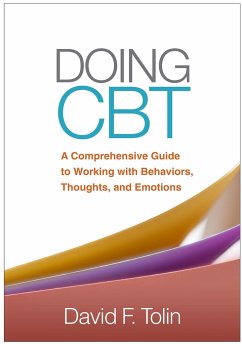David F. Tolin
Doing CBT, First Edition
A Comprehensive Guide to Working with Behaviors, Thoughts, and Emotions
David F. Tolin
Doing CBT, First Edition
A Comprehensive Guide to Working with Behaviors, Thoughts, and Emotions
- Gebundenes Buch
- Merkliste
- Auf die Merkliste
- Bewerten Bewerten
- Teilen
- Produkt teilen
- Produkterinnerung
- Produkterinnerung
This book has been replaced by Doing CBT, Second Edition, ISBN 978-1-4625-5412-6.
Andere Kunden interessierten sich auch für
![Buddhist Psychology and Cognitive-Behavioral Therapy Buddhist Psychology and Cognitive-Behavioral Therapy]() Dennis Tirch (United Sta The Center for Compassion Focused TherapyBuddhist Psychology and Cognitive-Behavioral Therapy44,99 €
Dennis Tirch (United Sta The Center for Compassion Focused TherapyBuddhist Psychology and Cognitive-Behavioral Therapy44,99 €![Dbt Principles in Action Dbt Principles in Action]() Charles R. Swenson (Uni University of Massachusetts Medical SchoolDbt Principles in Action51,99 €
Charles R. Swenson (Uni University of Massachusetts Medical SchoolDbt Principles in Action51,99 €![Spirituality, Religion, and Cognitive-Behavioral Therapy Spirituality, Religion, and Cognitive-Behavioral Therapy]() David H. Rosmarin (McLean Hospital / United S Harvard Medical SchoolSpirituality, Religion, and Cognitive-Behavioral Therapy34,99 €
David H. Rosmarin (McLean Hospital / United S Harvard Medical SchoolSpirituality, Religion, and Cognitive-Behavioral Therapy34,99 €![Making Cognitive-Behavioral Therapy Work Making Cognitive-Behavioral Therapy Work]() Deborah Roth Ledley (United States private practice)Making Cognitive-Behavioral Therapy Work35,99 €
Deborah Roth Ledley (United States private practice)Making Cognitive-Behavioral Therapy Work35,99 €![The Therapeutic Relationship in Cognitive-Behavioral Therapy The Therapeutic Relationship in Cognitive-Behavioral Therapy]() Nikolaos Kazantzis (Australia Monash University)The Therapeutic Relationship in Cognitive-Behavioral Therapy39,99 €
Nikolaos Kazantzis (Australia Monash University)The Therapeutic Relationship in Cognitive-Behavioral Therapy39,99 €![Experiencing CBT from the Inside Out Experiencing CBT from the Inside Out]() James Bennett-Levy (Australia University of Sydney)Experiencing CBT from the Inside Out58,99 €
James Bennett-Levy (Australia University of Sydney)Experiencing CBT from the Inside Out58,99 €![Reclaim Your Life from IBS Reclaim Your Life from IBS]() Melissa G. HuntReclaim Your Life from IBS25,99 €
Melissa G. HuntReclaim Your Life from IBS25,99 €-
-
-
This book has been replaced by Doing CBT, Second Edition, ISBN 978-1-4625-5412-6.
Produktdetails
- Produktdetails
- Verlag: Guilford Publications
- Seitenzahl: 594
- Erscheinungstermin: 29. September 2016
- Englisch
- Abmessung: 256mm x 185mm x 33mm
- Gewicht: 1206g
- ISBN-13: 9781462527076
- ISBN-10: 1462527078
- Artikelnr.: 44563572
- Herstellerkennzeichnung
- Libri GmbH
- Europaallee 1
- 36244 Bad Hersfeld
- gpsr@libri.de
- Verlag: Guilford Publications
- Seitenzahl: 594
- Erscheinungstermin: 29. September 2016
- Englisch
- Abmessung: 256mm x 185mm x 33mm
- Gewicht: 1206g
- ISBN-13: 9781462527076
- ISBN-10: 1462527078
- Artikelnr.: 44563572
- Herstellerkennzeichnung
- Libri GmbH
- Europaallee 1
- 36244 Bad Hersfeld
- gpsr@libri.de
David F. Tolin, PhD, ABPP, is founder and director of the Anxiety Disorders Center/Center for Cognitive Behavioral Therapy at The Institute of Living-Hartford Hospital and Adjunct Professor of Psychiatry at the Yale University School of Medicine. The author of over 150 scientific journal articles, Dr. Tolin has served as a principal investigator and scientific reviewer for the National Institutes of Health since 2003. He is a past president of the Society of Clinical Psychology (Division 12) of the American Psychological Association and a recipient of awards for Distinguished Contribution to the Science of Psychology, Distinguished Contribution to the Practice of Psychology, and Distinguished Lifetime Contribution to Psychology from the Connecticut Psychological Association.
1. Laying Out the Basics
I. Why Do People Suffer?
2. Oh, Behave!: The Behavioral System and How It Can Go Wrong
3. Stinkin' Thinkin': The Cognitive System and How It Can Go Wrong
4. I Got a Bad Feeling about This: The Emotional System and How It Can Go
Wrong
5. Creating Meaty Conceptualizations
II. How Do We Help?
A. How We Engage the Client
6. Therapy Assessment and Case Formulation
7. CBT Finesse
B. Behavior-Level Interventions
8. Adjusting the Triggers: Situation Selection and Stimulus Control
9. Contingency Management in Therapy
10. Direct Behavioral Prescriptions and Graded Task Assignment
11. Exposure
12. Behavioral Skill Training
C. Cognitive-Level Interventions
13. What's the Client Thinking?
14. Restructuring Thoughts
15. Leave Them Thoughts Alone
16. Going Deeper with Core Beliefs
17. Addressing Information-Processing Biases
D. Emotion-Level Interventions
18. Modulating Emotion
19. Distress Tolerance
III. Putting It All Together
20. William's CBT
21. Anna's CBT
22. Elizabeth's CBT
Appendix A. Further Reading
Appendix B. Tools for the Clinician
References
I. Why Do People Suffer?
2. Oh, Behave!: The Behavioral System and How It Can Go Wrong
3. Stinkin' Thinkin': The Cognitive System and How It Can Go Wrong
4. I Got a Bad Feeling about This: The Emotional System and How It Can Go
Wrong
5. Creating Meaty Conceptualizations
II. How Do We Help?
A. How We Engage the Client
6. Therapy Assessment and Case Formulation
7. CBT Finesse
B. Behavior-Level Interventions
8. Adjusting the Triggers: Situation Selection and Stimulus Control
9. Contingency Management in Therapy
10. Direct Behavioral Prescriptions and Graded Task Assignment
11. Exposure
12. Behavioral Skill Training
C. Cognitive-Level Interventions
13. What's the Client Thinking?
14. Restructuring Thoughts
15. Leave Them Thoughts Alone
16. Going Deeper with Core Beliefs
17. Addressing Information-Processing Biases
D. Emotion-Level Interventions
18. Modulating Emotion
19. Distress Tolerance
III. Putting It All Together
20. William's CBT
21. Anna's CBT
22. Elizabeth's CBT
Appendix A. Further Reading
Appendix B. Tools for the Clinician
References
1. Laying Out the Basics
I. Why Do People Suffer?
2. Oh, Behave!: The Behavioral System and How It Can Go Wrong
3. Stinkin' Thinkin': The Cognitive System and How It Can Go Wrong
4. I Got a Bad Feeling about This: The Emotional System and How It Can Go
Wrong
5. Creating Meaty Conceptualizations
II. How Do We Help?
A. How We Engage the Client
6. Therapy Assessment and Case Formulation
7. CBT Finesse
B. Behavior-Level Interventions
8. Adjusting the Triggers: Situation Selection and Stimulus Control
9. Contingency Management in Therapy
10. Direct Behavioral Prescriptions and Graded Task Assignment
11. Exposure
12. Behavioral Skill Training
C. Cognitive-Level Interventions
13. What's the Client Thinking?
14. Restructuring Thoughts
15. Leave Them Thoughts Alone
16. Going Deeper with Core Beliefs
17. Addressing Information-Processing Biases
D. Emotion-Level Interventions
18. Modulating Emotion
19. Distress Tolerance
III. Putting It All Together
20. William's CBT
21. Anna's CBT
22. Elizabeth's CBT
Appendix A. Further Reading
Appendix B. Tools for the Clinician
References
I. Why Do People Suffer?
2. Oh, Behave!: The Behavioral System and How It Can Go Wrong
3. Stinkin' Thinkin': The Cognitive System and How It Can Go Wrong
4. I Got a Bad Feeling about This: The Emotional System and How It Can Go
Wrong
5. Creating Meaty Conceptualizations
II. How Do We Help?
A. How We Engage the Client
6. Therapy Assessment and Case Formulation
7. CBT Finesse
B. Behavior-Level Interventions
8. Adjusting the Triggers: Situation Selection and Stimulus Control
9. Contingency Management in Therapy
10. Direct Behavioral Prescriptions and Graded Task Assignment
11. Exposure
12. Behavioral Skill Training
C. Cognitive-Level Interventions
13. What's the Client Thinking?
14. Restructuring Thoughts
15. Leave Them Thoughts Alone
16. Going Deeper with Core Beliefs
17. Addressing Information-Processing Biases
D. Emotion-Level Interventions
18. Modulating Emotion
19. Distress Tolerance
III. Putting It All Together
20. William's CBT
21. Anna's CBT
22. Elizabeth's CBT
Appendix A. Further Reading
Appendix B. Tools for the Clinician
References








